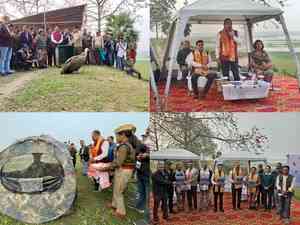Assam: Over 1 lakh migratory water birds of 124 species spotted in Kaziranga
A total of 1,12,062 migratory water and wetland-dependent birds of 124 species, the highest number for freshwater lakes in northeast India, counted in Assam's Kaziranga National Park and Tiger Reserve (KNPTR), officials said on Sunday.

Guwahati, Feb 2 (IANS) A total of 1,12,062 migratory water and wetland-dependent birds of 124 species, the highest number for freshwater lakes in northeast India, counted in Assam's Kaziranga National Park and Tiger Reserve (KNPTR), officials said on Sunday.
KNPTR Director Sonali Ghosh said that the sixth Kaziranga waterbird count exercise found 1,12,062 migratory water and wetland-dependent birds of 124 species higher than the fifth round (2023-24) of bird count exercise when 88,710 such birds were found against the fourth round's (2021-22) 66,776 birds.
She added that out of 124 species, 62 were winter migrants.
The results of bird count were announced on Sunday.
According to the IUCN (International Union for Conservation of Nature) red list, seven species are globally threatened and 15 are near-threatened.
Out of three divisions, Nagaon Wildlife Division recorded the highest number of species (107).
"Key sightings included the critically endangered Baer's Pochard and the Endangered Pallas's Fish Eagle. The Bar-headed Goose had the highest count at 20,845 individuals, while five other species-Knob-billed Duck, Baer's Pochard, Falcated Duck, White-tailed Eagle, and Greater white-fronted Goose were observed for the first time," said Ghosh, a senior Indian Forest Service officer.
She added that compared to other freshwater and Ramsar sites in India -- Nalsarovar (Gujarat), Keoadeo Ghana National Park (Rajasthan), Kolleru Lake (Andhra Pradesh), Wular Lake (Kashmir), Loktak Lake (Manipur), Deeporbeel (Assam), Rowmaribeel (Assam) and Donduwabeel (Assam) -- significant number of water birds found in the KNPTR.
The two-day (January 11 and 12), sixth Kaziranga Waterbird Count exercise this year saw the participation of five observers, four coordinators, and 93 enumerators, belonging to various institutions and government and non-government organisations, 62 volunteers from nearby local colleges and forest staff, thereby continuing to be one of the largest Citizen Science Movement of the country since the recent years.
The bird count exercise not only aimed to gather valuable data on waterbird populations but also fostered community involvement and awareness regarding the importance of wetland conservation, the KNPTR Director said.
The collaboration among various stakeholders highlighted the collective effort needed for effective wildlife conservation in Kaziranga.
The waterbird count was first initiated in the year 2018-19 by the management authority of KNPTR.
Over the years, Kaziranga's waterbird count exercise has evolved into an important tool for the management of wetlands of one of India's premier tiger reserves.
Ghosh said that there was no disruption in regular tourism activities during the conduct of the census to sensitise the importance of science-based conservation in protected area management.
According to the official, India hosts nearly 370 migratory bird species from three major flyways, with 310 predominantly using wetland habitats.
The country's diverse wetlands, spanning 15.26 million hectares, provide critical habitats for more than 200 waterbird species.
The birds typically follow the Central Asian Flyway (CAF) and East African-Eurasian Flyway (EAEF), using India's wetlands as important refueling stations during their long journeys, she said.
"These sites are critical for the birds' annual migration cycles, offering suitable wintering grounds and essential resources. Kaziranga and other wetlands in northeast India are important as they serve as wintering grounds for both the CAF and the EAEF flyways," the KNPTR director said.
The KNPTR, measuring about 1,300 sq km, is home to more than 2,613 one-horned Indian rhinos.
The world-famous park is not just a home to rhinos, but also to Asian elephants, Royal Bengal tigers, wild buffalos, and many more animal species while it is also a habitat to thousands of birds of more than 124 species.
India's seventh (fourth in natural) UNESCO World Heritage site, the KNPTR is spread across several districts of Assam, including Golaghat, Nagaon, Sonitpur, and Biswanath.
--IANS
sc/khz


 IANS
IANS 






